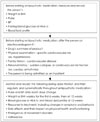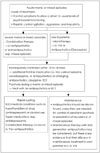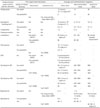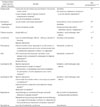Abstract
Bipolar disorder is a recurrent chronic condition and patients usually continue long-term medication from young age to prevent the recurrence of mood episodes. Antipsychotics play an important role in acute and maintenance treatment of bipolar disorder, even when patients experience no psychotic symptoms. Antipsychotics are also used in monotherapy and combination therapy involving mood stabilizers such as lithium or valproate. However, limited antipsychotics are currently approved by the US Food & Drug Administration ; 10 kinds of antipsychotics were approved for manic or mixed episodes, 3 for bipolar depression, and 5 for maintenance therapy. Before and after the use of antipsychotics, psychiatrists should carefully monitor baseline weight, pulse, blood pressure, fasting blood glucose or HbA1c, blood lipid profile, and electrocardiogram to evaluate QTc prolongation. During manic episodes or mixed features, antipsychotics rapidly control agitation, aggression, and impulsivity. Repetitive injections of typical antipsychotics are not implemented in bipolar patients as this practice is not evidence-based. However, long-acting injectable atypical antipsychotics are approved and feature support on maintenance therapy for bipolar patients. Although recent studies have shown the benefits of aripiprazole and olanzapine on rapid-cycling bipolar patients, few studies support the effectiveness of antipsychotics in suicide prevention. Moreover, while there is extensive evidence on the effectiveness of lithium in suicide or self-harm prevention. In conclusion, antipsychotics, especially aripiprazole, quetiapine, olanzapine, and risperidone, are effective to manage bipolar disorder in clinical settings. But weight gain and cardiac conductance should be carefully monitored before and during the use of antipsychotics.
양극성장애는 반복적인 기분삽화를 경험하는 만성 질환이며,1) 유병률은 전 세계적으로 유사하게 1% 정도로 파악되고 있다.2) 평균적으로 18세 경에 시작되어 삽화당 13주 정도의 지속기간을 나타낸다.3) Judd 등4)의 전향적 연구에 의하면, 추적관찰기간 동안 제 I형 양극성장애에서 47.3%의 기간 동안 기분삽화를 경험하였으며, 이중 우울증 시기가 31.9%, 조증/경조증 시기가 8.9%, 급속순환형/혼재성삽화 시기가 5.9%였다. 제 II형 양극성장애에서는 53.9%의 기간 동안 기분삽화를 경험하였으며, 이중 우울증 시기가 50.3%, 경조증 시기가 1.3%, 급속순환형/혼재성삽화 시기가 2.3%로 나타났다.5) DSM-5에서는 양극성장애가 기분장애에서 분리되어 “양극성 및 관련장애”로 구분되었고, 혼재성삽화라는 표현을 쓰지 않고, 대신에 혼재성 양상(mixed feature)을 명시자(specifier)로 사용하게 되었다.6) 제 I형 또는 제 II형 양극성 장애의 조증, 경조증 또는 우울삽화에 혼재성 양상 명시자를 적용할 수 있다.1) 자살의 위험도 일반인보다 높은데, 역학연구에 의하면 양극성장애 환자에서 자살률이 10만 명당 연간 164명에 달하며, 23~26%에서 자살시도 경험을 하는 것으로 보고되었다.6)
이처럼 만성적인 경과를 가지고 삽화가 반복되기 때문에 양극성장애 환자에서 기분 증상을 효과적으로 치료하는 것이 환자의 삶의 질을 개선시키고 기능을 향상시키는데 중요하다.7) 최근의 메타분석 연구에 의하면 양극성장애의 치료에서 항정신병약물이 lithium, valproate 등 기존의 기분안정제보다 더 우수한 효과와 내약성을 보인다고 하였다.89) 미국 식품의약품안전청(U.S. Food & Drug Administration, 이하 FDA)에서는 양극성장애의 기분삽화 종류에 따라 개별 항정신병약물의 승인 사항에 차이가 있다. 또한 장기적으로 약물을 복용해야 하는 질병의 특성상 부작용과 효과에 대한 이해가 중요하다. 양극성장애에서 항정신병약물의 사용 전략에 대해서 고찰해 보고자 한다.
항정신병약물은 조증 또는 혼재성 양상, 우울삽화, 유지기에 따라서 FDA의 승인 사항과 사용 용량에 차이가 있다(표 1). 현재 10종류의 항정신병약물[aripiprazole, asenapine, cariprazine, chlorpromazine, lurasidone, olanzapine, olanzapine-fluoxetine combination(이하 OFC), quetiapine, risperidone, ziprasidone]이 양극성장애에서 단독 또는 lithium, valproate와의 병합요법으로 승인을 받았으며, quetiapine은 즉시 방출형(IR)과 연장 방출형(XR) 두 가지 제형이 각각 승인을 받았다. 우울삽화에는 3개 약물(lurasidone, OFC, quetiapine), 유지기에는 5개 약물(aripiprazole, olanzapine, quetiapine, risperidone, ziprasidone)이 승인을 받았다. 하지만, 조증 또는 혼재성 양상, 우울삽화, 유지기 모두에 승인을 받은 약물은 현재까지는 quetiapine이 유일하다. 소아청소년의 경우에는 조증 또는 혼재성 양상에 5개의 약물(aripiprazole, asenapine, olanzapine, quetiapine, risperidone)이 승인을 받았다.
영국의 National Institute for Heath and Care Excellence (NICE) 가이드라인12)에 의하면 항정신병약물을 양극성장애 환자에 사용하기 전에 다음을 평가하고 의무기록에 기록하도록 권고하고 있다(그림 1). 1) 체중이나 body mass index (BMI), 2) 맥박, 3) 혈압, 4) 공복혈당 또는 당화혈색소(glycosylated hemoglobin, HbA1c), 5) 혈중 지질 프로파일(blood lipid profile)이 필요하다. 그리고 심전도가 필요한 경우는 1) 항정신병약물의 특성상 필요하다고 약물 요약서에 명시된 경우, 2) 신체 검진에서 고혈압과 같은 심혈관계 위험이 발견된 경우, 3) 심혈관계 질환의 가족력, 4) 갑작스럽게 쓰러진 병력, 부정맥과 같은 심혈관 위험 인자가 있는 경우, 5) 입원환자인 경우이다. 약물의 지속, 변경, 중단이 있을 때 의무기록에 근거와 효과를 기술하도록 하고 있다.
양극성장애 환자에서 항정신병약물을 사용하기로 결정이 되면, 각 약물의 장단점이 개별 환자에게 잘 맞는지 확인하는 과정이 필요하다(표 2). 또한, 환자의 삽화가 바뀜에 따라서 약물을 변경하는 것이 필요할 수 있다. Lithium, valproate 등 기분안정제(mood stabilizer)에 추가요법(adjunctive therapy)으로 사용할 것인지 단독으로 사용할 것인지에 대한 고려도 필요한데 증상이 심한 경우에는 추가요법을 추천하게 된다(그림 2). 양극성장애 환자에게 항정신병약물을 사용할 때는 추체외로계 증후군(extrapyramidal side effect, 이하 EPS), 지연성운동장애(tardive dyskinesia, 이하 TD), 체중 증가, 졸림, 성기능장애 등의 부작용 발생에 주의해야 한다. 이러한 부작용은 순응도를 떨어뜨리고 장기적으로 병의 경과를 악화시킨다.13) 비전형 항정신병약물은 전형 항정신병 약물 보다는 이러한 부작용이 적지만 여전히 심전도의 이상, 체중 증가, EPS 등을 발생시키는 경우가 흔하다. 이것은 양극성장애 환자들이 대부분 3~4종류의 약물을 장기 복용하는 경우가 많기 때문이다.13)
심전도의 문제에 대한 확인이 반드시 필요하다. 약물 사용 전과 사용 후에 모두 심전도의 문제를 확인해야 한다. 항정신병약물에 의해서 QTc prolongation이 발생하는 경우가 있는데 ziprasidone, quetiapine, olanzapine, risperidone, chlorpromazine과 같은 약물은 QTc prolongation을 aripiprazole, asenapine, cariprazine, lurasidone 보다 더 잘 일으킬 수 있으므로 주의가 필요하다(표 2). QTc가 500 msec 이상이 되면 항정신병약물 사용을 중단하고 심장내과 의사에게 환자를 의뢰해야 하고, 남성에서는 450 msec 이상, 여성에서는 470 msec 이상인 경우에는 약물의 감량이나 중단을 고려해야 한다.30) QTc prolongation이 지속되는 경우에 심실부정맥(ventricular arrhythmia),30) torsade de pointes31)의 위험이 증가할 수 있다. QTc가 증가하는 경우에는 항정신병약물 이외에도 병용약물(항우울제 등), 전해질(특히 K와 Mg)을 확인해 보는 것이 좋다.31)
급성 조증상태에서는 환자의 기분이 고양되어 충동성이 증가하고 수면이 줄어들어서 응급한 상태가 된다. 미국정신의학회 양극성장애 치료 가이드라인에 의하면,32) 이 시기의 목표는 신속하게 환자가 보이는 흥분, 공격성, 충동성을 조절하고, 정신사회적 기능을 원래 상태로 회복시키기 위해서 증상을 조절하는 데 있다(그림 1). 기분안정제의 복용만으로는 조증상태를 가라앉히는데 시간이 필요하므로 환자에게 자해나 타해의 위험이 발생할 수 있다. 전기경련요법의 경우도 시행 전 평가와 준비과정이 필요하기 때문에 기존에 적용해본 경우가 아니라면 응급으로 사용하기에 어렵다. 이 시기에는 자해 및 타해의 위험을 방지하기 위해서 항정신병약물 용량을 빠르게 증량해서 최대 용량까지 사용하게 되는 경우가 많다(표 1).
입원 환자에서 haloperidol 5 mg 제형은 근주(intramuscular) 또는 정주(intravenous)의 형태로 급성 조증상태의 충동성을 감소시키는데 임상적으로 널리 사용되고 있다. 급성 조증기에 5~10 mg의 haloperidol을 근주 하였을 때 안절부절(agitation) 증상을 줄이는데 lorazepam 근주보다 더 효과가 좋다는 보고가 있지만,33) 양극성장애 환자의 급성 조증상태에서 haloperidol 근주 또는 정주의 효과에 대해서 충분한 연구가 없고 FDA 허가 사항도 아니다. EPS, TD나 신경이완계 악성 증후군(neuroleptic malignant syndrome)의 발생 가능성에 대해서 주의를 기울여야 한다. 나머지 항정신병약물 중에서 장기지속형 주사제 이외에 근주나 정주로 사용할 수 있는 약물은 국내에 없다. 장기지속형 주사제는 정주하지 않도록 주의해야 한다(예 : haloperidol decanoate 50 mg/mL).
Canadian Network for Mood and Anxiety Treatment(이하 CANMAT)와 International Society for Bipolar Disorders (이하 ISBD)의 2018년 가이드라인34)에 의하면 양극성장애환자에서 안절부절(agitation) 증상을 단기간에 약물로 조절하는 데 있어 1차 치료방법은 aripiprazole, lorazepam, olanzapine을 근주하거나 loxapine을 흡입하는 것으로 제시하였다. 2차 치료 방법은 haloperidol을 근주하는 것으로, 3차 치료 방법은 haloperidol, quetiapine, risperidone을 경구 복용하는 것으로 제시하고 있다.
양극성장애 환자는 발병 이후 우울삽화를 조증, 경조증삽화보다 많이 오랜 기간 동안 경험하게 된다.45) 따라서 장기간 지속되는 치료에도 불구하고 우울증을 경험하게 되면 환자의 순응도가 떨어지고 삶의 질이 크게 저하되게 된다. 최근의 메타분석에 의하면 항정신병약물을 양극성 우울증 환자에서 고용량으로 사용하는 것은 저용량으로 사용하는 것에 비해서 호전율, 반응률, 관해율에 차이가 없다는 보고가 있다.35) CANMAT과 ISBD 2018년 가이드라인34)에서는 혼재성 양상인 경우에는 비전형성 항정신병약물이나 divalproex를 단독으로 사용하거나, 두 가지 약물의 병합요법을 사용하도록 하는 근거를 제시하고 있다. 정신병적 양상이 동반된 경우에는 전기경련요법이나 항정신병약물의 임상적 사용이 효과가 있다.34)
양극성장애의 유지기에는 재발을 방지하기 위해서 약물 순응도를 높이는 것이 중요한 문제가 된다. 급성 조증상태에 사용한 약물을 유지기에도 계속 유지하는 경우에 체중 증가, EPS, 인지기능저하 등의 문제가 발생할 수 있다. 미국정신의학회 양극성장애 치료 가이드라인에 의하면 유지기에는 급성기에 사용한 항정신병약물을 중단하는 것을 권고하고 있지만(그림 2),32) 최근 연구에 의하면 aripiprazole, quetiapine, ziprasidone 등 비전형 항정신병약물이 단독 혹은 lithium, valproate와 병합요법에서 재발을 방지하는 데 효과가 있고 내약성도 좋다고 보고되고 있다.836) 최근에는 aripiprazole,37) risperidone38) 장기지속형 주사제가 양극성장애의 유지기에 FDA 승인을 받았는데 기분삽화의 재발을 방지하는 데 도움이 되는 것으로 보고되었다. Olanzapine-Fluoxetine 복합제(OFC)는 양극성 우울증에서 FDA 승인을 받았는데, 이중맹검무작위 연구에 의하면 olanzapine 단독요법에 비해서 더 우울증에 효과는 좋고 약물 유발성 조증 위험과 부작용은 차이가 없는 것으로 보고되었다.39) Aripiprazole은 양극성 우울증에서 FDA 승인을 받지는 못했지만, 저용량인 5 mg 이하에서 제 II형 양극성장애의 우울증에 효과가 있다는 연구 결과가 있고,40) 심한 우울증상이 있는 경우에 더 효과가 있다는 분석 결과가 있다.41)
Lithium이 양극성장애의 자살(suicide),4445) 자해(self-harm) 및 비의도적 손상(unintentional injury)46)을 감소시키는 데 효과가 있다는 연구 결과가 일관되게 보고되고 있다. 이것은 lithium이 충동적 공격성(impulsive aggression)을 감소시키기 때문으로 생각된다.46) 하지만, 이에 비해서 항정신병약물의 사용이 양극성장애 환자의 자살 위험을 감소시키는 데 도움이 된다는 근거는 충분하지 않다. 양극성장애 환자에 대한 대규모 전향적 연구인 Systematic Treatment Enhancement Program for Bipolar Disorder(STEP-BD)에 의하면 자살생각, 흥미의 저하와 불안이 외래 환자에서 자살 행동의 위험을 증가시키는 위험요인이 된다고 밝혔다.47)
항정신병약물은 양극성 장애 환자의 조증, 혼재성 양상, 우울삽화, 유지기의 치료에 도움이 되지만 FDA에서 승인된 약물은 삽화별로 차이가 있다. 항정신병약물은 단독 혹은 lithium, valproate와 병합요법으로 효과가 있으며, 정신병적 증상이 동반되지 않은 양극성장애에도 증상의 관해 및 재발 방지에 효과를 나타낸다. 하지만, 사용 전에 체중, 당뇨 등 대사질환과 심장전도도에 대한 평가가 필요하다. 또한 lithium은 자살예방에 효과가 입증되었지만 항정신병약물은 그러한 효과가 입증되지 않았다. 양극성장애 환자가 복용해야 하는 약물의 선택을 할 때 단기적인 증상의 호전도 중요하지만 장기적인 관점에서 신체적, 정신적, 인지적, 사회적 측면에서 환자에게 주는 영향을 면밀히 고려해서 신중하게 선택하고 모니터하는 태도가 필요하다.
Figures and Tables
 | Fig. 1Flow to start antipsychotics medication in patients with bipolar disorders from the National Institute for Health and Care Excellence guideline.12) HbA1c : Glycosylated hemoglobin, BMI : Body mass index, BP : Blood pressure. |
 | Fig. 2Clinical Practice Guidelines of the American Psychiatric Association for antipsychotics in patients with bipolar disorders.32) ECT : Electroconvulsive therapy, R/O : Rule-out. |
Table 1

* : Asenapine is poorly absorbed when swallowed, † : Years of approved by FDA, ‡ : Including patients with bipolar II disorder, § : Adjunctive to lithium or valproate, ¶ : Twice daily. FDA : Food & Drug Administration, IM : Intramuscular, IR : Immediate-release, OFC : Olanzapine-fluoxetine combination, XR : Extended release
Acknowledgments
이 연구는 과학기술정보통신부와 한국연구재단의 뇌원천기술개발사업(No. NRF-2016M3C7A1947307 ; PI HJJ)과 바이오의료기술개발사업(No. NRF-2017M3A9F1027323 ; PI HJJ)의 도움으로 진행되었음.
References
1. American Psychiatric Association. Diagnostic and Statistical Manual of Mental Disorders. Fifth Edition. Washington, DC: American Psychiatric Association Publishing;2013.
2. Sadock BJ, Sadock VA. Kaplan and Sadock's synopsis of psychiatry: behavioral sciences/clinical psychiatry. 11th ed. Philadelphia: Wolters Kluwer;2014.
3. Solomon DA, Leon AC, Coryell WH, Endicott J, Li C, Fiedorowicz JG, et al. Longitudinal course of bipolar I disorder: duration of mood episodes. Arch Gen Psychiatry. 2010; 67:339–347.
4. Judd LL, Akiskal HS, Schettler PJ, Endicott J, Maser J, Solomon DA, et al. The long-term natural history of the weekly symptomatic status of bipolar I disorder. Arch Gen Psychiatry. 2002; 59:530–537.

5. Judd LL, Akiskal HS, Schettler PJ, Coryell W, Endicott J, Maser JD, et al. A prospective investigation of the natural history of the long-term weekly symptomatic status of bipolar II disorder. Arch Gen Psychiatry. 2003; 60:261–269.

6. Schaffer A, Isometsä ET, Tondo L, Moreno DH, Sinyor M, Kessing LV, et al. Epidemiology, neurobiology and pharmacological interventions related to suicide deaths and suicide attempts in bipolar disorder: part I of a report of the international society for bipolar disorders task force on suicide in bipolar disorder. Aust N Z J Psychiatry. 2015; 49:785–802.

7. Morton E, Murray G, Michalak EE, Lam RW, Beaulieu S, Sharma V, et al. Quality of life in bipolar disorder: towards a dynamic understanding. Psychol Med. 2018; 48:1111–1118.

8. Cipriani A, Barbui C, Salanti G, Rendell J, Brown R, Stockton S, et al. Comparative efficacy and acceptability of antimanic drugs in acute mania: a multiple-treatments meta-analysis. Lancet. 2011; 378:1306–1315.

9. Cipriani A, Rendell J, Geddes JR. Olanzapine in the long-term treatment of bipolar disorder: a systematic review and meta-analysis. J Psychopharmacol. 2010; 24:1729–1738.

10. Vieta E, Berk M, Schulze TG, Carvalho AF, Suppes T, Calabrese JR, et al. Bipolar disorders. Nat Rev Dis Primers. 2018; 4:18008.

11. Accessdata.fda.gov [homepage on the Internet]. Silver Spring: U.S. Food and Drug Administration;updated 2018 Nov 12. cited 2018 Nov 12. Available from: https://www.accessdata.fda.gov/scripts/cder/daf/index.cfm?event=overview.process&ApplNo=021436.
12. National Institute for Health and Care Excellence (NICE). NICE guidelines: using pharmacological treatments for bipolar disorder. London: NICE Publishing;2018.
13. Zarate CA Jr. Antipsychotic drug side effect issues in bipolar manic patients. J Clin Psychiatry. 2000; 61:Suppl 8. 52–61. discussion 62-63.
14. Nierenberg AA. A critical appraisal of treatments for bipolar disorder. Prim Care Companion J Clin Psychiatry. 2010; 12:Suppl 1. 23–29.

15. Leucht S, Cipriani A, Spineli L, Mavridis D, Orey D, Richter F, et al. Comparative efficacy and tolerability of 15 antipsychotic drugs in schizophrenia: a multiple-treatments meta-analysis. Lancet. 2013; 382:951–962.

16. Altınbaş K, Guloksuz S, Oral ET. Clinical potential of cariprazine in the treatment of acute mania. Psychiatr Danub. 2013; 25:207–213.
17. Li DJ, Tseng PT, Stubbs B, Chu CS, Chang HY, Vieta E, et al. Efficacy, safety and tolerability of aripiprazole in bipolar disorder: an updated systematic review and meta-analysis of randomized controlled trials. Prog Neuropsychopharmacol Biol Psychiatry. 2017; 79:289–301.

18. Scheidemantel T, Korobkova I, Rej S, Sajatovic M. Asenapine for bipolar disorder. Neuropsychiatr Dis Treat. 2015; 11:3007–3017.
19. Lao KS, He Y, Wong IC, Besag FM, Chan EW. Tolerability and safety profile of cariprazine in treating psychotic disorders, bipolar disorder and major depressive disorder: a systematic review with meta-analysis of randomized controlled trials. CNS Drugs. 2016; 30:1043–1054.

20. Gurovich I, Vempaty A, Lippmann S. QTc prolongation: chlorpromazine and high-dosage olanzapine. Can J Psychiatry. 2003; 48:348.

21. Kane JM. Lurasidone: a clinical overview. J Clin Psychiatry. 2011; 72:Suppl 1. 24–28.
22. Silva MT, Zimmermann IR, Galvao TF, Pereira MG. Olanzapine plus fluoxetine for bipolar disorder: a systematic review and meta-analysis. J Affect Disord. 2013; 146:310–318.

23. Endicott J, Paulsson B, Gustafsson U, Schiöler H, Hassan M. Quetiapine monotherapy in the treatment of depressive episodes of bipolar I and II disorder: improvements in quality of life and quality of sleep. J Affect Disord. 2008; 111:306–319.

24. Chiesa A, Chierzi F, De Ronchi D, Serretti A. Quetiapine for bipolar depression: a systematic review and meta-analysis. Int Clin Psychopharmacol. 2012; 27:76–90.
25. Samalin L, Tremey A, Llorca PM. Quetiapine extended release for the treatment of bipolar disorder. Expert Rev Neurother. 2014; 14:987–1005.

26. Kim SJ, Lee YJ, Lee YJ, Cho SJ. Effect of quetiapine XR on depressive symptoms and sleep quality compared with lithium in patients with bipolar depression. J Affect Disord. 2014; 157:33–40.

27. Sheehan DV, Harnett-Sheehan K, Hidalgo RB, Janavs J, McElroy SL, Amado D, et al. Randomized, placebo-controlled trial of quetiapine XR and divalproex ER monotherapies in the treatment of the anxious bipolar patient. J Affect Disord. 2013; 145:83–94.

28. Fenton C, Scott LJ. Risperidone: a review of its use in the treatment of bipolar mania. CNS Drugs. 2005; 19:429–444.
29. Bobo WV, Shelton RC. Risperidone long-acting injectable (Risperdal Consta®) for maintenance treatment in patients with bipolar disorder. Expert Rev Neurother. 2010; 10:1637–1658.

30. Coughtrie AL, Behr ER, Layton D, Marshall V, Camm AJ, Shakir SAW. Drugs and life-threatening ventricular arrhythmia risk: results from the DARE study cohort. BMJ Open. 2017; 7:e016627.

31. Nielsen J, Graff C, Kanters JK, Toft E, Taylor D, Meyer JM. Assessing QT interval prolongation and its associated risks with antipsychotics. CNS Drugs. 2011; 25:473–490.

32. American Psychiatric Association Steering Committee on Practice Guidelines. Treating bipolar disorder a quick reference guide. Washington, DC: American Psychiatric Association Publishing;2005.
33. Chouinard G, Annable L, Turnier L, Holobow N, Szkrumelak N. A double-blind randomized clinical trial of rapid tranquilization with I.M. clonazepam and I.M. haloperidol in agitated psychotic patients with manic symptoms. Can J Psychiatry. 1993; 38:Suppl 4. S114–S121.
34. Yatham LN, Kennedy SH, Parikh SV, Schaffer A, Bond DJ, Frey BN, et al. Canadian Network for Mood and Anxiety Treatments (CANMAT) and International Society for Bipolar Disorders (ISBD) 2018 guidelines for the management of patients with bipolar disorder. Bipolar Disord. 2018; 20:97–170.
35. Bartoli F, Dell'Osso B, Crocamo C, Fiorillo A, Ketter TA, Suppes T, et al. Benefits and harms of low and high second-generation antipsychotics doses for bipolar depression: a meta-analysis. J Psychiatr Res. 2017; 88:38–46.

36. Lindström L, Lindström E, Nilsson M, Höistad M. Maintenance therapy with second generation antipsychotics for bipolar disorder - A systematic review and meta-analysis. J Affect Disord. 2017; 213:138–150.

37. Calabrese JR, Sanchez R, Jin N, Amatniek J, Cox K, Johnson B, et al. Efficacy and safety of aripiprazole once-monthly in the maintenance treatment of bipolar I disorder: a double-blind, placebo-controlled, 52-week randomized withdrawal study. J Clin Psychiatry. 2017; 78:324–331.

38. Quiroz JA, Yatham LN, Palumbo JM, Karcher K, Kushner S, Kusumakar V. Risperidone long-acting injectable monotherapy in the maintenance treatment of bipolar I disorder. Biol Psychiatry. 2010; 68:156–162.

39. Tohen M, Vieta E, Calabrese J, Ketter TA, Sachs G, Bowden C, et al. Efficacy of olanzapine and olanzapine-fluoxetine combination in the treatment of bipolar I depression. Arch Gen Psychiatry. 2003; 60:1079–1088.

40. Kelly T, Lieberman DZ. The utility of low-dose aripiprazole for the treatment of bipolar II and bipolar NOS depression. J Clin Psychopharmacol. 2017; 37:99–101.

41. Yatham LN. A clinical review of aripiprazole in bipolar depression and maintenance therapy of bipolar disorder. J Affect Disord. 2011; 128:Suppl 1. S21–S28.

42. Schneck CD. Treatment of rapid-cycling bipolar disorder. J Clin Psychiatry. 2006; 67:Suppl 11. 22–27.
43. Fountoulakis KN, Kontis D, Gonda X, Yatham LN. A systematic review of the evidence on the treatment of rapid cycling bipolar disorder. Bipolar Disord. 2013; 15:115–137.

44. Smith KA, Cipriani A. Lithium and suicide in mood disorders: updated meta-review of the scientific literature. Bipolar Disord. 2017; 19:575–586.

45. Cipriani A, Pretty H, Hawton K, Geddes JR. Lithium in the prevention of suicidal behavior and all-cause mortality in patients with mood disorders: a systematic review of randomized trials. Am J Psychiatry. 2005; 162:1805–1819.





 PDF
PDF ePub
ePub Citation
Citation Print
Print



 XML Download
XML Download